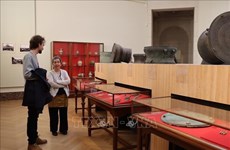Hanoi Ca tru club helps preserve traditional music
An old man passionately plays a three-string lute, while another man
beats castanets and a young woman sings classical songs.
An old man passionately plays a three-string lute, while another man
beats castanets and a young woman sings classical songs.
Ca tru, also known as Hat a dao, is an ancient type of music featuring female vocalists. It originated in northern Vietnam and was, like many traditional music genres, a form of entertainment for the royal court.
Many of 83-year-old musician Nguyen Van Mui's ancestors were singers and instrument players who served the Nguyen dynasty (1802-1945). Since he was a young boy, Mui followed his father, Nguyen Van Xuan, a renowned player of dan day (a plucked lute with three strings, a trapezoidal wooden body and a very long wooden neck with 10 raised frets) to participate in Ca tru performances.
"I went to school during the day and followed my father to perform every evening at many different places, so the sounds of drums, castanets and the +dan day+, as well as the tunes of Ca tru, became part of my life," the musician said.
By the time he grew up, however, this genre no longer had a place in society. The family's Thai Ha guild disbanded and the artists of their clan had to seek other ways to make a living.
Mui, however, wanted to preserve his family's ancestral heritage.
So they held singing sessions in their houses and invited noted singers and musicians such as People's Artist Quach Thi Ho, Meritorious Artist Nguyen Thi Phuc, and singers Pho Thi Kim Duc, Nguyen Thi Pham, Tran Thi Ngo, Pho Dinh Ky and Dinh Khac Ba. They also brought music researchers like Ngo Linh Ngoc, Nguyen Xuan Khoat and Chu Ha to review family memories, teaching their children to take responsibility for preserving the tradition.
Mui also sent his children to the famous artists, encouraging them to learn how to play instruments and sing Ca tru. His two sons, Nguyen Van Khue and Nguyen Manh Tien, became musicians and his daughter, Nguyen Thuy Hoa, became a singer.
In 1991, overseas Vietnamese musician Ton That Tiet from France came back to Vietnam to bring Ca tru artists overseas. Mui's family had their first concert in France, followed by tours around France, Belgium, Netherlands, England, Japan, and Switzerland.
These tours and their love for the art convinced the family to found the Ca tru Thai Ha Club, with members being descendants of the family.
With two performances per week on Hang Buom street, as well as events on Hang Bo, Tran Hung Dao and Nghi Tam streets, the club has helped bring back the traditional art form.
In 2000, the Ford Foundation and the Arts and Performance Department's sponsorship helped the club train members of nearly 30 local clubs from the central province of Quang Binh northward to northern delta provinces such as Bac Ninh and Vinh Phuc.
Ca tru was recently recognised by UNESCO as an Intangible Cultural Heritage in need of urgent safeguarding.
"When Vietnam prepared records to submit for UNESCO recognition, the researchers who made the profile such as Professor To Ngoc Thanh and researcher Dang Hoanh Loan came to us," Mui said proudly. "My family provided them with many songs that only exist in our clan. We also travelled with them to many places to study the art and make videos to submit to UNESCO."
Asked if he wanted a title or honour, Mui said: "I preserve Ca tru because I feel strongly about the priceless art forms of the nation, not titles or money. You see, artisans like me could barely make a living even if they wanted to.
"The State should offer more policies to support and assistance to veteran artists so they can be motivated and have more passion to teach the arts to younger generations. This should happen soon, as only a few old people of the Ca tru genre are still alive, and they will not be able to wait much longer.".-VNA
Ca tru, also known as Hat a dao, is an ancient type of music featuring female vocalists. It originated in northern Vietnam and was, like many traditional music genres, a form of entertainment for the royal court.
Many of 83-year-old musician Nguyen Van Mui's ancestors were singers and instrument players who served the Nguyen dynasty (1802-1945). Since he was a young boy, Mui followed his father, Nguyen Van Xuan, a renowned player of dan day (a plucked lute with three strings, a trapezoidal wooden body and a very long wooden neck with 10 raised frets) to participate in Ca tru performances.
"I went to school during the day and followed my father to perform every evening at many different places, so the sounds of drums, castanets and the +dan day+, as well as the tunes of Ca tru, became part of my life," the musician said.
By the time he grew up, however, this genre no longer had a place in society. The family's Thai Ha guild disbanded and the artists of their clan had to seek other ways to make a living.
Mui, however, wanted to preserve his family's ancestral heritage.
So they held singing sessions in their houses and invited noted singers and musicians such as People's Artist Quach Thi Ho, Meritorious Artist Nguyen Thi Phuc, and singers Pho Thi Kim Duc, Nguyen Thi Pham, Tran Thi Ngo, Pho Dinh Ky and Dinh Khac Ba. They also brought music researchers like Ngo Linh Ngoc, Nguyen Xuan Khoat and Chu Ha to review family memories, teaching their children to take responsibility for preserving the tradition.
Mui also sent his children to the famous artists, encouraging them to learn how to play instruments and sing Ca tru. His two sons, Nguyen Van Khue and Nguyen Manh Tien, became musicians and his daughter, Nguyen Thuy Hoa, became a singer.
In 1991, overseas Vietnamese musician Ton That Tiet from France came back to Vietnam to bring Ca tru artists overseas. Mui's family had their first concert in France, followed by tours around France, Belgium, Netherlands, England, Japan, and Switzerland.
These tours and their love for the art convinced the family to found the Ca tru Thai Ha Club, with members being descendants of the family.
With two performances per week on Hang Buom street, as well as events on Hang Bo, Tran Hung Dao and Nghi Tam streets, the club has helped bring back the traditional art form.
In 2000, the Ford Foundation and the Arts and Performance Department's sponsorship helped the club train members of nearly 30 local clubs from the central province of Quang Binh northward to northern delta provinces such as Bac Ninh and Vinh Phuc.
Ca tru was recently recognised by UNESCO as an Intangible Cultural Heritage in need of urgent safeguarding.
"When Vietnam prepared records to submit for UNESCO recognition, the researchers who made the profile such as Professor To Ngoc Thanh and researcher Dang Hoanh Loan came to us," Mui said proudly. "My family provided them with many songs that only exist in our clan. We also travelled with them to many places to study the art and make videos to submit to UNESCO."
Asked if he wanted a title or honour, Mui said: "I preserve Ca tru because I feel strongly about the priceless art forms of the nation, not titles or money. You see, artisans like me could barely make a living even if they wanted to.
"The State should offer more policies to support and assistance to veteran artists so they can be motivated and have more passion to teach the arts to younger generations. This should happen soon, as only a few old people of the Ca tru genre are still alive, and they will not be able to wait much longer.".-VNA












